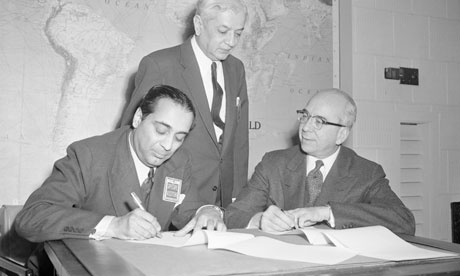
Architect of India's atomic energy programme laid the foundations for a thorium research programme
Admiral Lewis Strauss (right) chairman of the Atomic Energy Commission, and Homi Bhabha (left), the secretary of India's Atomic Energy Commission, sign a 1956 deal for heavy water, which the US is selling to six nations to help develop their atomic energy programmes. Photograph: Bettmann/Corbis
Despite decades of relative neglect compared with conventional nuclear power, research into thorium is now forging ahead around the world.
But it is thanks to the vision of Homi Bhabha, the architect of India's atomic energy programme, that India is a world leader in thorium research and development. He died in a plane crash in 1966 aged 56, but had already laid the foundations for a research programme that is now beginning to bear fruit.
India's government-controlled nuclear power industry has been criticised in the past for lack of transparency and inadequate safety oversight. But it has its admirers around the world. "India has the most technically ambitious and innovative nuclear energy program in the world," Siegfried Hecker, a former director of the Los Alamos National Laboratory in the US, wrote in a recent issue of Physics Today. "The extent and functionality of its nuclear experimental facilities are matched only by those in Russia and are far ahead of what is left in the US."
Canada, Russia, Japan, the US and the EU all have active thorium research programmes. And China too is now sinking considerable resources into the field. It officially launched its thorium-based reactor project, led by the son of a former Chinese president, at a meeting of the Chinese Academy of Sciences in Shanghai earlier this year.
"The commonly used (uranium-based) nuclear reactor isn't a 'perfect stove', and burns only a small proportion of the highest quality fuel, leaving a lot of 'cinder'," a lead researcher told a Shanghai newspaper. "We need a better stove that can burn more fuel."
The Chinese have chosen a different technology path from India in the quest for a thorium reactor – liquid-fluoride instead of heavy water. The International Atomic Energy Agency lists other technologies that are being explored in international thorium research projects. All have yet to prove that thorium reactors can be commercially viable. As far back as 1983, for instance, a high temperature 300MW thorium power reactor was commissioned in Germany, but shut down six years later as it was not found economically feasible.

0 comentarios:
Publicar un comentario